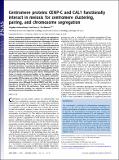| dc.contributor.author | Unhavaithaya, Yingdee | |
| dc.contributor.author | Orr-Weaver, Terry | |
| dc.date.accessioned | 2014-08-28T15:15:54Z | |
| dc.date.available | 2014-08-28T15:15:54Z | |
| dc.date.issued | 2013-12 | |
| dc.date.submitted | 2013-08 | |
| dc.identifier.issn | 0027-8424 | |
| dc.identifier.issn | 1091-6490 | |
| dc.identifier.uri | http://hdl.handle.net/1721.1/89084 | |
| dc.description.abstract | Meiotic chromosome segregation involves pairing and segregation of homologous chromosomes in the first division and segregation of sister chromatids in the second division. Although it is known that the centromere and kinetochore are responsible for chromosome movement in meiosis as in mitosis, potential specialized meiotic functions are being uncovered. Centromere pairing early in meiosis I, even between nonhomologous chromosomes, and clustering of centromeres can promote proper homolog associations in meiosis I in yeast, plants, and Drosophila. It was not known, however, whether centromere proteins are required for this clustering. We exploited Drosophila mutants for the centromere proteins centromere protein-C (CENP-C) and chromosome alignment 1 (CAL1) to demonstrate that a functional centromere is needed for centromere clustering and pairing. The cenp-C and cal1 mutations result in C-terminal truncations, removing the domains through which these two proteins interact. The mutants show striking genetic interactions, failing to complement as double heterozygotes, resulting in disrupted centromere clustering and meiotic nondisjunction. The cluster of meiotic centromeres localizes to the nucleolus, and this association requires centromere function. In Drosophila, synaptonemal complex (SC) formation can initiate from the centromere, and the SC is retained at the centromere after it disassembles from the chromosome arms. Although functional CENP-C and CAL1 are dispensable for assembly of the SC, they are required for subsequent retention of the SC at the centromere. These results show that integral centromere proteins are required for nuclear position and intercentromere associations in meiosis. | en_US |
| dc.description.sponsorship | National Institutes of Health (U.S.) (Grant GM39341) | en_US |
| dc.description.sponsorship | G. Harold and Leila Y. Mathers Foundation | en_US |
| dc.language.iso | en_US | |
| dc.publisher | National Academy of Sciences (U.S.) | en_US |
| dc.relation.isversionof | http://dx.doi.org/10.1073/pnas.1320074110 | en_US |
| dc.rights | Article is made available in accordance with the publisher's policy and may be subject to US copyright law. Please refer to the publisher's site for terms of use. | en_US |
| dc.source | PNAS | en_US |
| dc.title | Centromere proteins CENP-C and CAL1 functionally interact in meiosis for centromere clustering, pairing, and chromosome segregation | en_US |
| dc.type | Article | en_US |
| dc.identifier.citation | Unhavaithaya, Y., and T. L. Orr-Weaver. “Centromere Proteins CENP-C and CAL1 Functionally Interact in Meiosis for Centromere Clustering, Pairing, and Chromosome Segregation.” Proceedings of the National Academy of Sciences 110, no. 49 (November 18, 2013): 19878–19883. | en_US |
| dc.contributor.department | Massachusetts Institute of Technology. Department of Biology | en_US |
| dc.contributor.department | Whitehead Institute for Biomedical Research | en_US |
| dc.contributor.mitauthor | Orr-Weaver, Terry L. | en_US |
| dc.relation.journal | Proceedings of the National Academy of Sciences | en_US |
| dc.eprint.version | Final published version | en_US |
| dc.type.uri | http://purl.org/eprint/type/JournalArticle | en_US |
| eprint.status | http://purl.org/eprint/status/PeerReviewed | en_US |
| dspace.orderedauthors | Unhavaithaya, Y.; Orr-Weaver, T. L. | en_US |
| dc.identifier.orcid | https://orcid.org/0000-0002-7934-111X | |
| mit.license | PUBLISHER_POLICY | en_US |
| mit.metadata.status | Complete | |
